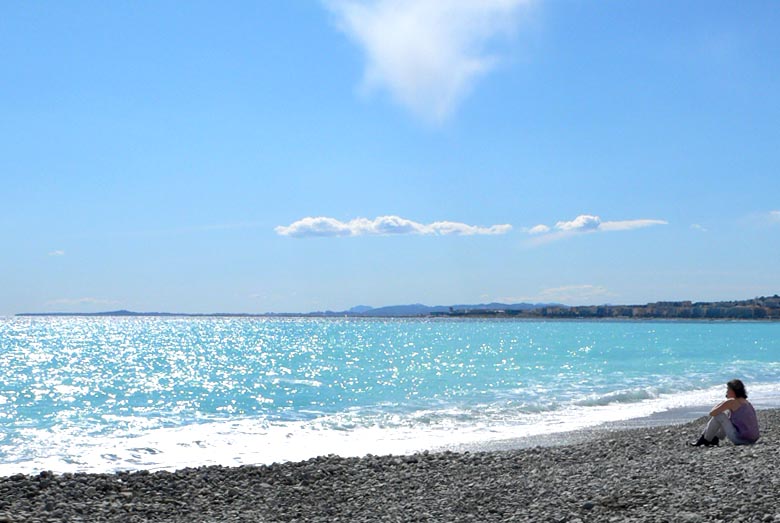Saorge, Fontan memorial ceremony
Saorge is a very beautiful medieval village perched along a narrow rock spur that juts out into the Vallée de la Roya, high above the river. Saorge is classed as one of the "40 most beautiful villages of France".
http://www.beyond.fr/villages/saorge.html
To get to Saorge from Nice, the A8 takes one into Italy, before the S20 goes back into France and to Saorge. We stopped off in Airole, an Italian village, to look for a restaurant, but the only two seemed to be closed. It's an amazing medieval warren:

And the "Happy Days Bar" wasn't quite what we were looking for:

Back in France we found a restaurant with terrace in Breil sur Roya, which seemed to be a quiet village. But once seated there was an incredible noise, which I assumed was someone cutting stone, or some other building work. But the waitress explained that it was model power-boats on the river. As with the bloody motor-bikes in Nice, just a few nuts ruin the peace for everyone else - a clear case for a ban. Until then - don't stop if you're looking for some calm:

Saorge IS a haven of calm:

Like Airole, Saorge has incredible little medieval streets:


The main street:


The communal laundry - labour-saving devices avoid a great deal of hard work, but can lead to social isolation - what gossip must have been exchanged here:

The Franciscan monastery - how many lives were wasted here?

At least now it is used to provide places for writers to work in peace - and to show art - sadly, the current stuff was very boring abstract painting:
http://pagesperso-orange.fr/anne.slacik
The monastery was founded at about the time Galileo was being silenced:

When we left Saorge we arrived in nearby Fontan, with incredible timing, just as the road was blocked by the memorial day procession (May 8th).
At 02:41 on May 7, 1945, at the SHAEF headquarters in Reims, France, the Chief-of-Staff of the German Armed Forces High Command, Colonel General Alfred Jodl, signed the German Instrument of Surrender. All active operations were to cease at 23:01 Central European Time on May 8
http://en.wikipedia.org/wiki/Victory_in_Europe_Day
So M parked and I got some photos.


In the History Channel an American doubts if many Americans today know about the significance of the day:
The act of military surrender was signed on May 7 in Reims, France, and May 8 in Berlin, Germany.
Surprised no one posted anything about this historic day. My Dad told me once that when they were told the war in Europe was over, the GIs had to turn in all their ammunition and fire off what they had in their weapons. He thought 'I sure hope somebody told the Germans this is over'.
63 years ago this day. I doubt a large number of Americans walking around today could even tell you what VE Day meant let alone who we fought against. Pretty sad state of affairs.
Ironmike
History channel

We tried to celebrate being alive with a drink on Beaulieu beach.
The day after writing that, I read this in the International Herald Tribune:
Johnny pulled guard from 9 to 11
Patrick Logan
... After my father died in 1997, I found his wartime letters to my mother. Germany's imminent surrender was a frequent theme, along with a longing for home. One topic was taboo: death.
...
Attending Mass in the village of Belvedere on a Sunday in October, my father escaped injury when German artillery shelled the town. His best friend, a man named Johnny, was not so lucky. In a letter to my mother soon after, the realities of war forced my father to forget his self-censorship.
"A month after Johnny was killed, his wife wrote me. She must be very religious or something because she wanted to know if Johnny had gone to church that morning he was killed. Johnny couldn't go to mass that morning. We went to the nine o'clock mass and Johnny pulled guard from 9 to 11. He planned to go then. We went to the church basement and Father Lambert finished the service there. It wasn't till about 10:30 that I heard that Johnny had been killed.
...
My father lived. I live. Millions of Americans can say these two words because someone came home from a war decades ago. If those Americans were lucky, they learned what my father taught me: to celebrate life by realizing how fortunate you are to have it.
http://www.iht.com/articles/2008/05/09/opinion/edlogan.php
Unfortunately, by the time we descended from the A8, the beach cafe was closing, so we couldn't sit and enjoy this view at Beaulieu:

So we had drinks in the lovely garden of La Reserve, from which we could just see the sea through the restaurant. A very nice end to the day with the lovely M:

As Logan's father said:
"celebrate life by realizing how fortunate you are to have it."


















